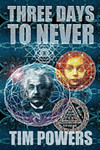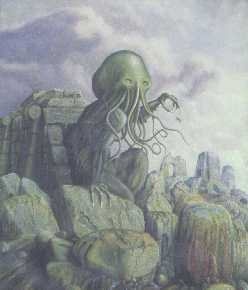[NOTE: A lot of folks in other countries see the site at unsual hours, and I didn’t want this week’s special event to get buried under other posts and be less visible over the weekend, so I moved the two relevant posts to the top. This should also make it easier for folks who want to participate but who couldn’t read the story during work hours. For an explanation of what we’re doing see here.–ja]
Through and Through
by Tim Powers
ALREADY when he walked in through the side door, there were new people sitting here and there, separately in the Saturday afternoon dimness. The air was cool, and smelled of floor-wax.
He almost peered at the shadowed faces, irrationally hoping one might be hers, come back these seven days later to try for a different result; but most of the faces were lowered, and of course she wouldn’t be here. Two days ago, maybe—today, and ever after, no.
The funeral would be next week sometime, probably Monday. No complications about burial in consecrated soil anymore, thank God . . . or thank human mercy.
His shoes knocked echoingly on the glossy linoleum as he walked across the nave, pausing to bow toward the altar. In the old days he would have genuflected, and it would have been spontaneous; in recenter years the bow had become perfunctory, dutiful—today it was a twitch of self-distaste.
There were fewer people than he had first thought, he noted as he walked past the side altar and started down the wall aisle toward the confessional door, passing under the high, wooden Stations of the Cross and the awkwardly lettered banners of the Renew Committee. Maybe only three, all women; and a couple of little girls.
They never wanted to line up against the wall—a discreet couple of yards away from the door—until he actually entered the church; and then if there were six or so of them they’d be frowning at each other as they got up out of the pews and belatedly formed the line. silently but obviously disagreeing about the order in which they’d originally entered the church.
Last week there had been five, counting her. And afterward he had walked back up to the front of the church and stepped up onto the altar level and gone into the sacristy to put on the vestments for 5:30 Mass. Had he been worrying about what she had said? What sins you shall retain, they are retained. Probably he had been worrying about it.
As he opened the confessional door now, he nodded to the old woman who was first in line. The others appeared to be trying to hide behind her—he could see only a drape of skirt and a couple of shoes behind her. He didn’t recognize the old woman.
He stepped into the little room and pulled the door closed behind him. They wouldn’t begin to come in until he turned on the red light over the door, and he needed a drink.
Continue reading “Through And Through”
 I’m reading Tim Powers’ new novel, Three Days to Never.
I’m reading Tim Powers’ new novel, Three Days to Never. 
